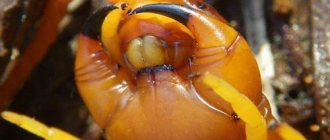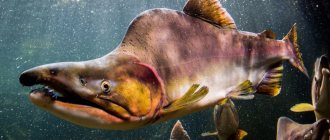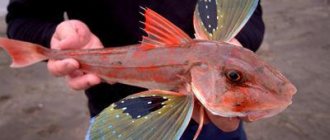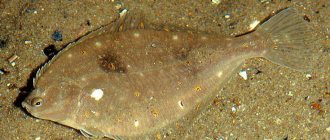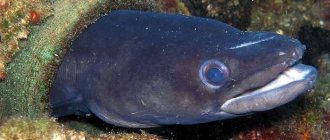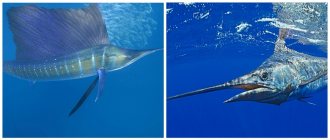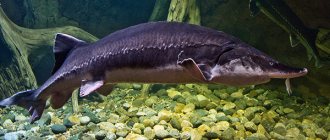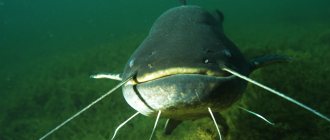For the most part, the inhabitants of the Black Sea are harmless and do not pose a threat to people, which makes it one of the safest in the world. But some of them can cause serious harm to health, even death. Like the Black Sea stingray (or sea cat), which has a large poisonous spine and immediately uses it in case of danger. This graceful and dangerous fish is a frequent visitor to coastal waters and its meetings with humans are regular, so it’s worth getting to know it better.
Spreading
The Black Sea stingray (official name Dasyatis pastinaca ) is one of 88 members of the family, loves warm subtropical waters and is widely represented in the Eastern Atlantic, from the shores of the Baltic Sea to the Western coast of Africa. This is the only species that lives in the Azov and Black Seas , preferring the latter.
Being a bottom-dwelling fish, it prefers sandy and muddy bottoms, where it partially buries itself for camouflage purposes. It is mainly found at shallow depths, up to 60 meters, but can migrate deeper, depending on the season and water temperature. It swims in shallow waters and to rocky shores, and sometimes swims into river mouths.
Types of stingrays
In total, there are 8 genera in the family, which include 88 species of stingrays, of which there are 44 stingrays. Let’s look at the most interesting representatives.
Black Sea
Tourists and travelers who decide to visit the Black Sea coast or divers who want to replenish their trophies with a graceful stingray or its poisonous spine need to be extremely careful in the water. Because of its flat shape, the fish is not always noticeable in the thickness of the sea’s muddy or sandy bottom; it is possible to accidentally step on it and provoke an attack. The stingray ray enters the Black Sea only in the summer; in the fall it swims away to warm waters. Breeds at the end of June, in July, feeds on small fish.
Yandex pictures
Mostly fishermen who carelessly sort through their catch suffer from its needles, but a light injection cannot cause much harm, only slight redness and temporary swelling at the site of injury. For some reason, fish is not eaten, but fishermen from a dynasty or with great experience know how to cook Black Sea stingray very tasty. Knowledgeable people advise eating sea cat meat to increase potency; it is a natural aphrodisiac. In other countries, stingrays are commercially fished. In the Black Sea waters and in the Sea of Azov it is possible to find only two species of this fish.
sea fox
Like the Black Sea stingray, it swims into the Black and Azov Seas, but is much more modest in size and is not found more than 1.2 meters in length and 4 kg in weight. The diamond shape is more pronounced than that of the sea cat, the poisonous spine and electrical defense organs are weakly expressed. The skin is all spiky, spotted or patterned, the belly is white. The spiny stingray is the most common European species and is interesting for breeding. The female lays huge eggs, up to 5 cm in diameter (up to 170 per year), from which a 9-12 centimeter cub appears after 5 months. It feeds on crustaceans and bottom organisms, prefers a depth of 20-300 meters, but has also been found at depths of 577 m.
Yandex.Pictures
Far Eastern
This large fish lives in the tropical waters of the Pacific Ocean, preferring shallow waters and extrusions. In the photo, the Far Eastern stingray is noticeably distinguished by its tail, which is longer than the disc, has a reddish-brown skin color, and reproduces by ovoviviparity. It is a valuable commercial fish, due to its tasty meat and liver, its numbers are sharply declining. Length up to two meters, weight 10.7 kg, disc width 66 cm.
pixabay.com
Description
The Black Sea stingray has a wide and flattened body, without bones (only cartilage, the animal is a cartilaginous fish), rounded diamond-shaped, with a slightly protruding snout. On the upper (dorsal) part there are eyes, behind which there are white sprays through which water enters the gills. They are larger and when opening/closing it gives the impression that the fish is “blinking”. In the lower part there are gill slits and a mouth with two rows of blunt small teeth in the form of plates, from 30 to 40 pieces in each.
The stingray's body ends with a tail (in adults it is almost equal to the length of the body, in young animals it is 1.5 times longer), in the central part of which a jagged pike-spike grows, reaching 15-20 centimeters in length. With the help of ducts, poison is supplied to it, which is injected into the victim’s body during the blow. It is because of this characteristic feature that the fish received the prefix name “stalker”. At times the spikes break, so there may be 2 or 3 of them.
The thorn prick is very painful, and the symptoms resemble poisoning by snake venom: malaise, cardiac arrhythmia, swelling, vomiting. While not considered lethal, they can be fatal if applied to the area of vital organs. Such cases are reliably known. Recovery takes several days, but injection wounds take a long time to heal.
Important! As usual, the Black Sea stingray does not attack humans, avoiding crowds of people or noise, and is shy. But if you step on it or “drive it into a corner”, trying to pull it ashore, it hits you with its tail immediately, and the force of the blow and the sharpness of the spike allows you to pierce clothes and light shoes.
The lower part of the stingray is light, dirty white, the upper part is dark, gray-brown and dirty green-olive. The body is smooth and not covered with scales. On average, its dimensions reach 60-70 centimeters in length (width is not much greater than length) and 8-10 kilograms in weight, and together with the tail from a meter, but in warmer and southern seas 20-kilogram specimens are found 2-2.5 meters. Females are usually larger than males.
Needles and poison
Closer to the base, on the long curved tail like a cat's, the stingray has a jagged needle. It reaches 20 cm, in large individuals up to 35 centimeters. The spike has a groove at the bottom in which toxic glands are located. The injection is very painful and poisonous, but does not pose a mortal danger to humans; only in case of panic or convulsions is it possible to choke and die. Throughout its life, the stingray grows up to three spines if one of them breaks during an attack, but sea cats with 2-3 spines are often found.
The fish is not distinguished by its aggressive disposition; in captivity it quickly gets used to and even recognizes its owner, but in natural conditions tragic cases occur. Incidents of attacks on people:
- 2006 - a huge stingray killed famous Australian reptile tamer Steve Irwin with a blow to the chest (heart area) during underwater filming.
- 2016 - Singapore Aquarium employee, professional driver Philip Chen, who worked there for 25 years, was attacked by a stingray and died in hospital from his injuries.
- 2018 - on Lauderdale Beach, off the coast of Tasmania, a stingray killed an Australian with a blow to the stomach; the vacationer suffered cardiac arrest.
The poison of the sea animal has been known for a long time to the Malaysian, Australian aborigines and Central American Indians, who used its thorn in hunting as an arrow point. The Athenian tragedian Sophocles described how Odysseus was killed with just such a spear.
WARNING: The danger is that each jagged groove on the spike contains poison, and the back-curved barbs prevent immediate removal of the toxic needle. Individual intolerance to the toxin, a blow to the heart, multiple injuries and painful shock can also lead to death. There are not many tragic cases, but you should not neglect caution, especially when swimming or fishing on the Black Sea coast, where the sea cat is found in abundance.
Nutrition
By the nature of its feeding, the Black Sea stingray is a predator. Its diet consists of benthic invertebrates, shrimp, shellfish and small fish. The latter occupies a small part, increasing as the slope grows. It is worth noting that the stingray spine is not used for hunting. It is intended solely for self-defense.
The stingray hunts from an ambush, which it arranges at the bottom of the sea. To do this, he lowers himself onto the soil, pressing himself as tightly as possible to it and sprinkling himself with a small amount of sand, camouflaging himself. If “for lunch” there are mussels or other mollusks with shells, then the teeth are used, easily crumbling the protection.
The stingray's favorite time to hunt is dusk or night, when it is most active. his second name - sea cat - precisely because of this feature. A special enzyme helps him see well at night - guanine, which forms a mirror-like layer in the eyes, which, when exposed to it, improves even the darkest and dullest picture. Combined with the ambush attack, this makes its habits very similar to the behavior of pets.
Lifestyle of stingrays
Stingrays live alone, usually at the bottom of the sea. Most often, sea cats can be found in shallow water. They rest on a muddy or sandy bottom, and are partially or entirely buried in the ground, leaving only their eyes, nose and tail outside.
In European waters, sea cats can only be found in the summer; it is believed that in winter they go to deeper waters. But according to another version, during cold weather they burrow deeper into the sand.
Sea cats hunt mainly for bottom crustaceans, as well as mollusks and bony fish.
When the stingray is angry, it beats its tail, bringing the poisonous needle into a state of readiness. This is an incredibly powerful weapon that can paralyze a swimmer. It can cause serious injury and even death.
Reproduction
By the nature of reproduction, the sea cat is an ovoviviparous fish, and the fry emerges from the mother’s womb already fully adapted to life. But even here the stingray stands out. The fact is that the embryo in the egg feeds not only on the yolk, but also on the histotroph (a nutrient similar in function and purpose to mother’s milk).
Small stingrays (about 8 cm “in the body” and 20 cm in length) appear in June-July, and the total period of pregnancy and gestation is up to 120 days. After birth, the tailed bells disperse throughout the water area, without subsequently showing any signs of “kinship” relationships.
The maximum lifespan of stingrays is 10 years, and in captivity they can live up to 20. They lead an isolated lifestyle, rarely gathering in large groups.
Stingray Habitat
These stingrays live in temperate and tropical zones. And in the North they are found on the southern Scandinavian coast. They are distributed in the Baltic Sea, along the African coast, in the Marmara, Mediterranean, Black and Azov Seas. In the Atlantic Ocean, stingrays swim near the Azores and Canary Islands.
Stingrays are found in all the world's seas.
Basically, these stingrays stay close to the shore; they can often be found near coastal cliffs. The typical biotome of the stingray is shallow water with a muddy or sandy bottom. They can be found at depths from 1 to 200 meters.
Spiny shark, or katran
Lives in the Black, Barents, Okhotsk and Japanese seas. Length up to 2 meters. It is called spiny for its two strong, sharp spines, at the base of which there are poisonous glands located in front of the dorsal fins. With them, the katran is capable of inflicting deep wounds on an unlucky fisherman or a careless scuba diver. An inflammatory reaction develops at the site of the lesion: pain, hyperemia, swelling. Sometimes there is a rapid heartbeat and slow breathing. We should not forget that the katran also has shark teeth, despite its modest size. Its poison, unlike the others, contains mainly myotropic (acting on muscles) substances and has a rather weak effect, so in the vast majority of poisoning people ends in complete recovery.
Reproduction of sea cats
Spawning most often occurs in the spring. One female brings from 2 to 9 fry. The birth of babies occurs in the summer. The development of fry occurs in eggs attached to the walls of the oviduct.
The babies hatch in the mother's body. At first, they feed on the substance contained in the egg yolk, and the grown fry feed on a protein-rich liquid that is secreted from the walls of the uterus and is somewhat reminiscent of milk.
Scientists do not know when stingrays reach sexual maturity.
Stingrays and people
Stingray meat is not widely used due to the fact that it is of low quality: tough, fatty, and has an unpleasant taste and smell.
Sometimes the needles of these stingrays are used as weapons, for example, they are used to make spear tips. Fish oil is made from stingray liver. The liver of stingrays contains up to 63% fat. In some European countries, you can find smoked or dried stingray meat on sale.
Stingrays are dangerous for people; they can easily kill a person. Most often, the stingray attacks a person when he steps on it in the sand. Jagged needles can cause serious injury. And the venom of sea cats is very toxic, it provokes muscle spasms, paralysis, causes severe pain and can even lead to death.
The sea cat has a poisonous needle in the middle of its tail; in large individuals it can reach a length of 35 cm.
Number of stingrays
Although their food is shellfish, and shellfish are extremely sensitive to environmental pollution, stingrays are not in danger of extinction.
It is worth noting that the available data is not sufficient to estimate the number of stingrays. The number of stingrays in different parts of the range has been poorly studied. But it is clear that in most places they are not abundant marine inhabitants. So in the Mediterranean Sea, only 0.5% of stingrays are caught in nets. But in the Balearic Islands this figure is much higher - up to 40% of the total catch. Since stingrays mainly live near the coast, they experience great negative influence from humans.
If you find an error, please select a piece of text and press Ctrl+Enter.
Are Black Sea stingrays dangerous?
The Black Sea stingray prefers peace and rarely swims close to the shore. But you still need to always be careful. Be especially careful in spring and autumn. It’s scarier to be on wild and empty beaches.
Divers often encounter this representative of marine fauna when diving below 5 m in depth. It is more comfortable to stay in water if it has a temperature of up to 18°. The chances of encountering marine life increase when the water temperature is 12-16°.
If we consider whether the stingray is dangerous, then it is worth saying that it is not the individual itself that is dangerous, but its limb. More precisely, it is worth paying attention to the spike that is marked at the end of the tail. Outwardly, it is very similar to a dagger. This thorn has special glands that produce dangerous poison. If a sea creature hits its tail, the poison gets onto the victim. You should not rely on your fearlessness, as adult specimens are excellent fighters. They make excellent use of natural weapons, instantly delivering terrible attacks. This spike can even pass through a diving suit.
Yandex pictures
Symptoms of injury include:
- slow heart rate;
- acute pain;
- rapid breathing;
- the appearance of redness and swelling at the site of injury;
- blood pressure surges;
- heart failure.
If a person is injured by a stingray, it is necessary to wash the wound as quickly as possible using ammonia. Seek medical help immediately after this.
But, fortunately, the stingray itself avoids people, so it prefers to lie on the bottom. It is much easier for him to immediately retire if a large predator or person is nearby. Therefore, representatives of the vile fauna try to prevent contact with divers.
If a diver notices an individual, it is better not to make sudden movements. Theoretically, an ordinary person can also meet fish. But if you notice a dark body with a diamond shape, you should not scare the specimen and stay away from it.
Sea ruffe, or Black Sea scorpionfish - Scorpaena porcus
This is a real monster - a large head covered with outgrowths, horns, bulging crimson eyes, a huge mouth with thick lips. The rays of the dorsal fin are turned into sharp spines, which the scorpionfish, if disturbed, spreads out; at the base of each ray is a poisonous gland. This is the ruff’s protection from predators, its weapon of defense. And the attack weapon - jaws with many sharp crooked teeth - are intended for careless fish that approach the scorpionfish within the distance of its swift, furious throw. The whole appearance of the scorpionfish speaks of its danger; and at the same time it is beautiful - and there are scorpionfish of very different colors - black, gray, brown, raspberry-yellow, pink...
These prickly predators lurk between stones, under algae, and, like all bottom-dwelling fish, change color to match the color of their surroundings and can quickly lighten or darken depending on the light. The scorpionfish is also hidden by numerous outgrowths, spines and leathery tentacles, turning it into one of the stones overgrown with marine vegetation. Therefore, it is difficult to notice her, and she herself relies so much on her inconspicuousness that she floats away (or rather, flies away like a bullet from a gun!) only if you approach her closely. Sometimes you can even touch it - but that’s exactly what you shouldn’t do - you’ll get pricked! It’s more interesting to watch a scorpionfish hunt while lying on the surface of the water and breathing through a snorkel...
There are two species of scorpionfish in the Black Sea - the noticeable scorpionfish Scorpaena notata, it is no more than 15 centimeters in length, and the Black Sea scorpionfish Scorpaena porcus - up to half a meter - but such large ones are found deeper, further from the coast. The main difference between the Black Sea scorpionfish is its long, rag-like flaps, supraorbital tentacles. In the noticeable scorpion fish these outgrowths are short. The poisons they secrete are especially dangerous in early spring. Fin pricks are very painful.
Wounds from scorpionfish thorns cause burning pain, the area around the injections turns red and swells, then general malaise, fever, and your rest is interrupted for a day or two. Wounds should be treated like regular scratches. The main symptoms of poisoning by sea ruffe are local inflammation (where they were injected) and a general allergic reaction. Therefore, the only tablets that can help are antiallergic (antihistamine) drugs - remember that you must strictly follow the instructions for use of the tablets that come with all medications. There are no known deaths from scorpionfish injections. No one steps on it by accident either - curious divers and fishermen suffer from its thorns when they remove the ruff from a hook or take it out of a net. By the way, the sea ruffe is a very tasty fish, but you need to clean it carefully - the poison is retained even by scorpionfish that have been in the refrigerator.
In small doses, the toxin causes local inflammation of tissues, in large doses it causes paralysis of the respiratory muscles. The venom of the sea ruffe contains mainly substances that act on the blood, so the symptoms of poisoning in victims persist for several days and then go away without complications.
Stingrays in captivity
Occasionally, sea cats are kept in aquariums with sea water. But their maintenance is quite troublesome, since they require a very large volume. In addition, stingrays are very demanding on temperature conditions and water composition.
Despite this, sea cats are successfully kept in some large aquariums. For example, you can admire these marine inhabitants at the aquarium in Alushta.
Stingrays are not in danger of extinction.
